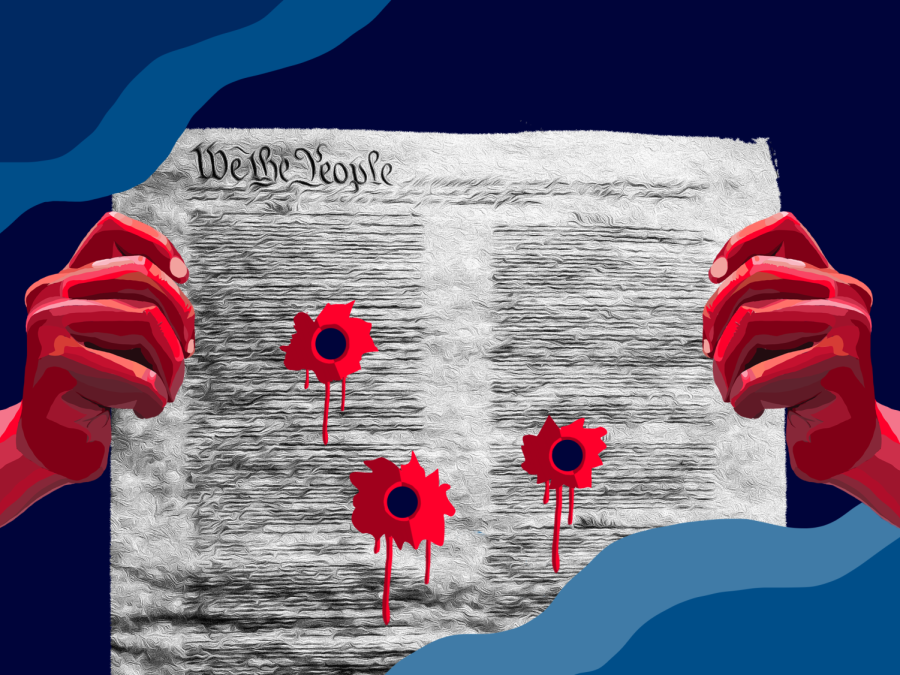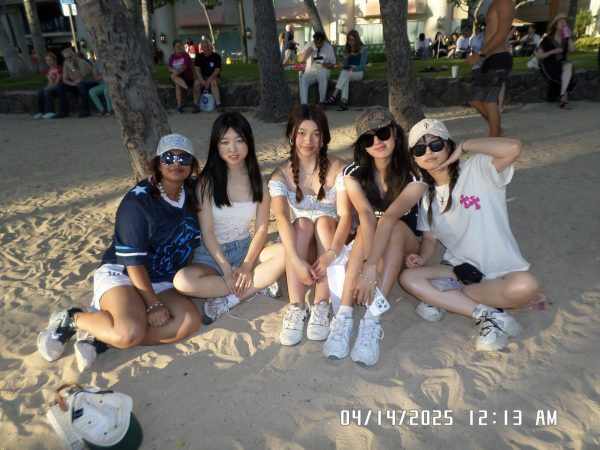Bulletproof beliefs
Gun owners and advocates share their perspectives on Second Amendment rights
The Second Amendment protects the constitutional right to keep and bear arms Graphic | Sonia Verma
The gun dealer in this story is anonymous due to privacy and safety concerns and will be referred to as Dealer A.
As a child, the allure of cowboys, army shows and war movies fueled Woodshop and Engineering teacher Ted Shinta’s fascination with guns. Shinta recalls that most families around him owned guns, and he received his first BB gun when he was 8 years old. Despite his father’s disapproval, Shinta later purchased firearms after moving out, driven by his keen interest in guns and concerns about personal security.
Shooting became a therapeutic and calming activity for Shinta, providing mental and physical relaxation. He frequently visited the Sunnyvale Rod & Gun Club for target shooting, sometimes multiple times a week. However, Shinta has begun reevaluating his views on gun rights as he gets older.
“We have a culture of violence and guns, and I think the first thing people do when they get mad is to pull a gun nowadays, and I’ve changed my mind on this whole thing,” Shinta said. “I’m not going to say I want to take everybody’s gun because if there was a ban, I think you [would] have to compensate the owners for the value of their firearms, but that would be very prohibitive.”
Like Shinta, senior Andrew Smithwick enjoys shooting at gun ranges and plans to buy a firearm as soon as he turns 18. For Smithwick, the Second Amendment holds significant importance in constitutionally protecting the gun rights of law-abiding citizens, which he considers essential, even in the face of increased gun violence.
“A criminal trying to attack you is infringing on your rights, life and liberty,” Smithwick said. “To stop those threats, you need access to the most effective tool possible or whatever tool you see fit. I think the government really has no place to decide what is appropriate for people to defend themselves.”
Dealer A, who owns a gun dealership in Santa Clara County, shares Smithwick’s perspective and has personally taken action to promote Second Amendment rights, especially for the Chinese community. After leaving China in 1997, Dealer A served in the United States Navy from 2002 to 2006, where they developed a love for firearms, eventually leading them to open their dealership in 2015.
Dealer A states that 70% of their customers purchase guns for home defense or personal protection, while the remaining 30% buy guns for recreational shooting, hunting or to add to their collections. They note that their business saw a surge in 2020 as people lost faith in law enforcement and sought ways to safeguard themselves against external threats.
“After George Floyd’s death, law enforcement has lost their public trust from citizens and people don’t want to rely on 911 calls,” Dealer A said. “I don’t trust the police anymore — they may hurt me. People don’t want to rely solely on law enforcement to rescue them when someone is trying to hurt them, and they want to have some tool they can use for self-defense when they fear for their lives.”
Smithwick also observed an increase in gun sales, particularly in urban areas. Smithwick says gun owners are becoming more diverse, with a growing number of people of color and women owning firearms. He thinks the shift in ownership demographics reflects the desire to have guns for self-defense.
On the other hand, Shinta, who has lived in California his entire life, believes the Bay Area has significantly fewer gun owners than it did when he was growing up. He attributes this decrease to changing demographics and increased difficulty purchasing firearms.
“It used to be easy [to buy guns] in the olden days,” Shinta said. “Ever since Ted Kennedy was assassinated, California has had fairly stringent laws.”
One of the more recent developments in California’s gun laws has been the 2019 ban on certain types of guns for those under 21. Dealer A believes 21 is too young to own a firearm as people’s brains haven’t fully developed, and he only feels comfortable selling to those 24 and older.
In contrast, Smithwick says those 18 and older should be able to bear arms, as they are considered legal adults, eligible to vote and serve in the military. He thinks the age limit is arbitrary and instead advocates for more gun education and training.
“A lot of times, people get their hands on a gun and have no idea what they’re doing with it,” Smithwick said. “I think we need to be promoting how to be safe with guns and properly use them — that would reduce a lot of accidental deaths.”
Dealer A shares Smithwick’s sentiment and emphasizes the importance of implementing more comprehensive background checks and training to minimize firearm-related accidents. As a self-described responsible gun owner, Dealer A takes precautions by unloading all their firearms and storing them separately from the ammunition. As a parent of two kids, they have made an effort to inform them about the danger of guns and says it is paramount to educate children on how to handle firearms properly.
While Smithwick and Dealer A’s belief that proper education and training are essential in reducing accidental deaths resonates with Shinta, he is more concerned about non-accidental deaths. He mentions that recent media coverage of gun violence, especially mass shootings, has impacted his perception of gun rights.
“You can’t turn the news on without seeing [gun violence], and you’re thinking, is it worth the risk to society to have these things around?” Shinta said.
Smithwick considers media coverage of mass shootings problematic due to the excessive attention given to the shooters. He says the sensationalized coverage of mass shooters only gives them the attention and notoriety they crave, potentially inspiring copycats.
“I can’t count how many headlines I’ve seen just discussing who the shooter was,” Smithwick said. “I am actually of the opinion that we should not even publicly release the names of mass shooters — we should not be giving the shooters themselves any attention whatsoever. The people who want to do this type of thing, oftentimes, there is an aspect of wanting that attention.”
Smithwick acknowledges that gun violence is a significant issue in the U.S. Nonetheless, he believes that implementing gun control measures similar to those in European countries would not be effective due to America’s deep-seated gun culture.
“Gun ownership and gun culture have been so ingrained in America that implementing, say, European-style gun laws is going to have a lot of unintended consequences,” Smithwick said. “If we were to look at what would happen if the U.S. tried to pass those laws, we would look a lot more like Latin America in terms of gang violence and cartels.”
Dealer A also expresses skepticism about limiting access to guns as an effective solution in the U.S. Given their concerns about the safety of their children at school, Dealer A hopes that all schools, including the one their children attend, will add armed security guards, conduct more preparation and drills, install bulletproof windows and reinforce classroom doors.
By and large, Smithwick attributes the rise of gun violence to the mental health crisis and says people who commit mass shootings are often lonely, depressed and socially ostracized. Thus, Smithwick believes there should be a greater focus on mental health to decrease violent incidents.
“When you feel like people have been beating down on you, everyone’s against you and you’re being crammed into this corner, some people just feel a need to lash out,” Smithwick said. “If we [want] to stop school shootings, we need to be providing more counselors, making [mental health resources] more available and promoting them more, because a lot of the time, [mental health issues] can be overcome relatively easily. People get stuck in that hole and keep themselves in it because they don’t have the right care.”
In addition to the mental health crisis, Smithwick says that improving socioeconomic conditions and addressing inequality would decrease gun violence.
 “We need to look at what causes people to go and commit crimes with guns, things like poverty, education and job opportunities,” Smithwick said. “I think if we were able to make it so that there was less of an incentive for people to just go and commit a crime, then we’d inherently see a reduction in gun violence.”
“We need to look at what causes people to go and commit crimes with guns, things like poverty, education and job opportunities,” Smithwick said. “I think if we were able to make it so that there was less of an incentive for people to just go and commit a crime, then we’d inherently see a reduction in gun violence.”
Ultimately, Smithwick dismisses the notion that gun control legislation is the only solution to gun violence, emphasizing that current gun rights can still be upheld. Smithwick argues that addressing what causes individuals to commit mass shootings is crucial, rather than solely focusing on regulating guns may infringe on the rights of individuals.
“You have to tackle the factors that lead people to [commit] mass shootings instead of just regulating guns, because then you trample over the rights of innocent people,” Smithwick said. “In the U.S., you simply can’t [enact gun control] without severely infringing on the freedoms of ordinary people, who, at the end of the day, do not deserve that.”









